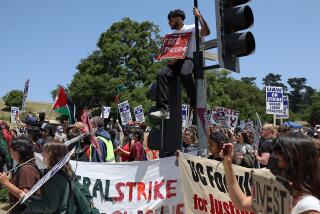Retreats Promote Peace on Campus
The trouble started, as it had before, with a look. Two girls, two cultures and one dismissive glance.
What are you looking at?
What are you looking at?
It was barely lunchtime--not the way to start off a three-day camping trip to promote peace.
Herbert Hoover High needs more peace. In three months last year, the Glendale school endured five students’ deaths, among them a killing, a car accident and a suicide. But usually it is the petty fights that make the campus tense.
“It’s small stuff,” said Hoover Co-Principal Pamela Good. “But it leads to people getting killed.”
To try to prevent those exchanges--often between Armenian Americans and Latinos--from escalating to violence, Hoover recently sent most of its 712 freshmen on retreats to the San Bernardino Mountains Ciara above Redlands.
The four trips are being paid for with a $500,000 grant from the U.S. Department of Education. The federal program was developed after the 1999 Columbine massacre to help make large high schools seem smaller and more close-knit.
Some of the teenagers who attended the retreats saw snow for the first time, and it made them giddy as kindergartners. Others had never spent a night away from home. Through workshops, late-night talks and some vegetarian cafeteria food, enemies became friends. Fourteen-year-old boys drew hearts with pink pencils, and students saw their principals and teachers dance, crack corny jokes and, in some cases, cry. The girls on the bus made up.
Although two nights in a drafty cabin and some role-playing games will not make the 2,700-student school safer or raise test scores immediately, it can go a long way toward helping kids drop their guard, adults at Hoover said.
“As much as we want our kids to do well academically,” Good said, “it’s not going to happen until they feel safe and connected.”
Hoover is not a bad school by any measure. On California’s academic ranking, it is in the middle. Average. Its students, judging by the diverse group of 70 who attended a retreat last month, are friendly, typical teenagers.
Most are either Armenian American or Latino. Some talk back to their teachers and have tragic personal stories. Others have loving parents, confidence and, in the case of one boy, 16 pet iguanas.
The retreats’ organizers knew they would not get all the freshmen to the mountains. Some parents refused to let their kids go. Some students simply had no interest. One girl said she went because her parents promised her $100.
The camps were designed for freshmen, to foster a campus community that will continue in the next three years. But Krestina Akearian, a senior, ended up benefiting, too. The 17-year-old was among several upperclassmen sent as camp counselors. She was swept up in the staring contest between the two girls at the back of the bus.
After welcoming the group to Camp Cedar Falls on a snowy Wednesday afternoon, Hoover Assistant Principal John Fox got angry at the girls involved in the stare-down.
“You have too much hate in you!” he said.
Melodrama ensued. More offending looks were exchanged, doors were slammed and other girls from the bus pleaded with teachers to smooth things over. Krestina knew she had to make the first move, but it wasn’t easy. To keep fighting would set a bad example for the ninth-graders.
“I can’t go up to somebody and say, ‘Sorry.’ I’ve never done it,” she said. “I don’t even say I’m sorry to my mom.”
The staring match stemmed from an after-school fight in front of Hoover two days before. Krestina was not involved, but her friends were. They are Armenian American. The other girls involved are Latino. At Hoover, that is often all it takes to start a fight.
Last May, dozens of students saw senior Raul Aguirre clubbed with a tire iron and stabbed in the heart after he tried to break up a fight between a Latino teenager and two Armenians, who had allegedly flashed gang signs at each other.
“The reason that grant was written is because Raul died,” said Linda Maxwell, a facilitator at the retreat. “And the reason there was money for that grant is because kids at Columbine died.”
Last fall, in part because of the Colorado killings, the Smaller Learning Communities Program awarded grants to more than 350 schools in 39 states. Congress has set aside $125 million to continue to fund the program.
“The reason I’m here is [it’s terrible] to bury kids,” Maxwell told the students the first day.
She and Jose Quintanar are known in Glendale as peacemakers who work with gang members and teenagers. Through their organization, We Care for Youth, Maxwell and Quintanar have counseled Krestina for six years.
Krestina eventually smoothed things over with the girls on the bus. You’re me, she told them, just three years younger.
“I used to have attitude, too,” she said. “It’s going to build up, and one day it’s going to take over you.”
Her message helped. One girl involved in the stare-down on the bus walked up to the microphone as camp closed and apologized.
Not every moment was heavy. There was plenty of giggling and hugging, joking and karaoke.
But there were emotional moments. At one retreat, Alvia Invencion, 14, was the first to cry. She had witnessed the after-school fight that sparked the incident on the bus, and she knew one of the participants in a fight on campus. She knew before the fight that her friend had planned to settle some scores but had done nothing to stop her.
“I didn’t take her seriously,” Alvia said. “Maybe if I just listened.”
Tears slid down her cheeks. She sniffled and shook. More words came out, but they stopped making sense. Someone handed her a tissue.
The next day, Alvia used colored pencils and a flowerlike pattern to draw her mandala, like the Buddhist monks who work for days creating an elaborate design from colored sand and then sweep it up and toss the sand in a river. Maxwell and Quintanar have used the exercise hundreds of times. The mandalas tell them about the kids and can alert them to problems.
“I’m very lost, sensitive, hurt and afraid,” one freshman wrote on the back of her mandala. “But I believe there is hope . . . somewhere. The little white heart [in the center of a solid black circle] is my little ray of hope.”
Maxwell told the students: “If you have a question--a big question, like ‘Should I have sex?’--look at your mandala and see if it fits. This is you, according to you.”
The camp motivated Alvia to sign up for some activities at Hoover, she said. She is thinking about the club for Filipinos, and a few others.
With nearly all of the ninth grade attending the camps, relations among students at school will improve, Alvia predicted.
“Bring It Back to Hoover” was one of the slogans during camp. What good is it if they learn to control their anger, work as a team and study harder and then apply those skills only in the mountains?
But the students learned at camp that pride and fear are powerful forces. They can make you snap at someone for looking at you wrong.
On the bumpy return to Glendale, after two nights in the chilly woods, there was too much fatigue for fighting. At the back of one bus, two girls who had argued on the way to the mountains were napping on each other’s shoulders.
A student asked, “Will this camp make a change back in Hoover?”
Three weeks later, some students say they have noticed a difference: The freshmen are talking more and fighting less.
More to Read
Start your day right
Sign up for Essential California for news, features and recommendations from the L.A. Times and beyond in your inbox six days a week.
You may occasionally receive promotional content from the Los Angeles Times.






